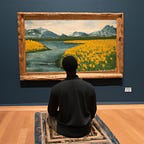4 Reasons Why Building Something is Important
The Art of Leaving a Legacy
--
Percy Bysshe Shelley’s iconic poem, “Ozymandias,” and the timeless theme of leaving a lasting legacy are intricately intertwined. While Ozymandias, the self-proclaimed “King of Kings,” sought to immortalize his power and dominion through grand monuments, his story ultimately serves as a cautionary tale about the fleeting nature of human achievements. This essay aims to explore the profound connection between Shelley’s poem and the universal human desire to create a legacy that endures beyond our mortal existence.
In the poem, Shelley presents us with a shattered statue in the desert, once a colossal representation of Ozymandias’ greatness. This imagery evokes a powerful sense of impermanence and decay, emphasizing the stark contrast between the ruler’s audacious proclamations and the barren landscape that remains. Through this exploration, we delve into the implications of Ozymandias’ futile quest for immortality and its relevance to our own aspirations to leave a lasting mark on the world.
In a world characterized by constant change and fleeting trends, the pursuit of longevity often takes a back seat to immediate gratification and instant results. Yet, there exists a timeless allure to creating something that transcends the ephemeral and stands the test of time. From ancient structures that have withstood centuries to enduring works of art and literature, the importance of building something permanent extends beyond the realm of physicality. In this blog, we will explore the philosophical significance of constructing lasting legacies and delve into the reasons why investing our time and efforts into creating something enduring can be deeply fulfilling.
1. The Human Desire for Immortality:
At the core of our being lies an innate desire for immortality, a yearning to leave behind a lasting imprint on the world. While our mortal existence may be finite, the products of our creation possess the potential to outlast us, granting us a sense of continuity and purpose beyond the confines of our own lives. Whether it is through the construction of architectural marvels, the composition of timeless music, or the written word that captures the essence of human experience, building something permanent allows us to transcend the boundaries of our existence and connect with future generations.
2. Legacy and Human Connection:
Building something that endures fosters a deep sense of connection between individuals across time and space. When we create works that stand the test of time, we join a lineage of human ingenuity, contributing to a shared narrative that stretches far beyond our individual lives. The Egyptian pyramids, Shakespeare’s plays, or Mozart’s symphonies are all testaments to the human capacity to forge connections that traverse generations. By engaging in the act of creation with an eye towards permanence, we participate in a collective endeavor to understand and express the human condition, connecting us to both the past and the future.
3. Cultural and Intellectual Preservation:
Enduring creations serve as repositories of knowledge, culture, and wisdom. They preserve the essence of societies, allowing future generations to glean insights into the collective psyche and historical context of a bygone era. From ancient scriptures to revered artworks, these lasting artifacts carry the voices and perspectives of those who came before us, offering profound insights into their struggles, triumphs, and the lessons they learned along the way. By building something that withstands time’s eroding grasp, we contribute to the preservation of the rich tapestry of human civilization, ensuring that our collective heritage endures.
4. Personal Growth and Fulfillment:
The act of building something that stands the test of time is not only a contribution to society but also a transformative journey for the individual. It demands patience, dedication, and a long-term perspective that transcends immediate gratification. As we invest our time, energy, and passion into creating something permanent, we develop valuable virtues such as discipline, perseverance, and the ability to think beyond our own lifespans. In the face of adversity and the inevitability of change, our commitment to enduring creations fosters personal growth and an enduring sense of fulfillment.
While the allure of instant gratification and transient accomplishments may tempt us, the importance of building something that stands the test of time cannot be understated. By creating works that endure, we tap into the deeply ingrained human desire for immortality, forge connections with past and future generations, preserve culture and knowledge, and experience personal growth along the way. In a world that is constantly evolving, the act of constructing something permanent serves as an anchor that grounds us, offering a profound sense of purpose and contributing to the rich tapestry of human existence. So, let us embrace the Permanence Paradox and strive to leave behind lasting legacies that resonate through the ages.
Ultimately, “Ozymandias” serves as a profound meditation on the transience of power and the quest for immortality. As we embark on our own journeys of self-discovery and seek to leave a legacy behind, we must heed the cautionary tale of Ozymandias, and reflect upon the true nature of lasting impact. Through an exploration of Shelley’s poetic masterpiece, we are compelled to confront our own mortality, contemplate the impermanence of our creations, and uncover the profound meaning of a legacy that transcends the constraints of time.
